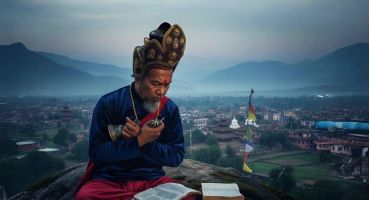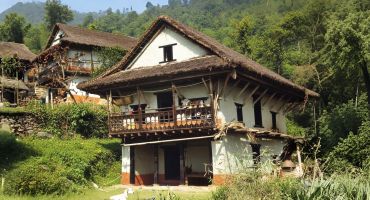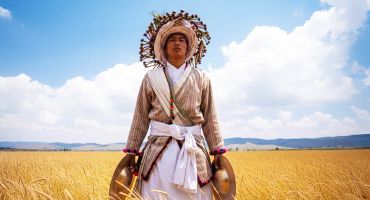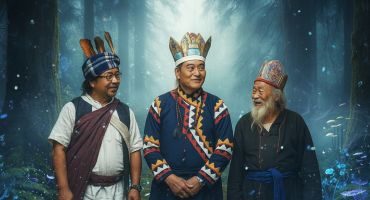Comprehensive understanding of the social history and culture of the Thami people remains sparse and fragmented. For generations, the Thami have primarily preserved and transmitted their cultural heritage through oral traditions, passing down stories, myths, and knowledge from one generation to the next. This reliance on oral discourse has meant that much of their historical and cultural narrative is embedded in the spoken word, requiring a meticulous and critical approach to studying these oral traditions. At a glance, Thami culture may seem complex and unconceivable. However, despite the challenges, a wealth of knowledge can be gleaned from their rich culture, intricate traditions, and unique language.
The Thangmi, also known as Thami, represent a unique ethnic group within the Tibetan-Burmese linguistic family. In their everyday interactions, the Thangmi refer to their language as Thangmi Kham or Thangmi Wakhe, and themselves as Thangmi. However, in elevated ritual contexts, some shamans use the term Thani. The name Thangmi has two potential etymologies in the Tibetan language. One interpretation is “than-mi,” signifying “people of the pasture lands,” while the other is “mthah-mi,” meaning “barbarians of the borders.” Anthropologists, such as J. Casper Miller and Alexander MacDonald, regard the latter explanation as more plausible. The Nepali designation for this group is ‘Thami’, an external ethnolinguistic perspective that has become prevalent today.
Two primary oral traditions elucidate the origins and migratory history of the Thangmi. The first posits that the Thangmi are descendants of the Kirati rulers who once held sway over Kathmandu until their displacement by the Lichhavi rulers. Following the fall of the Kirati, a faction journeyed through Sanga, and Benighat, ultimately settling in Kira Chhap around the Dolakha region. This narrative, however, is less substantiated by other oral traditions.

A more widely accepted narrative among the Thangmi traces their lineage to Yappati Chhuku/Ya’apa and Sunari Aama/Aaji. According to this myth, the Thangmi migrated along the Tamakoshi River from Simangadh and Kumangadh in the Sindhuli and Bara districts, eventually settling near Nagdah in Dolakha. After the decline of Kirati rule in Nepal, they dispersed, following various rivers towards eastern Nepal. The migration patterns of different Kirati groups led to the formation of distinct ethnic identities: those following the Tamor River became Limbus, those along the Arun became Rai/Khambu, the Dudhkoshi travelers became Sunuwar, the Sunkoshi followers became Hayu, and those tracing the Tamakoshi became Thangmi. This particular narrative details seven primary male and female clans, as well as five additional clans who were the descendants of Ya’apa and Sunari Ama.
Beyond Nepal’s borders, they also reside in Sikkim and Darjeeling, India, indicating a transnational presence influenced by historical migration patterns and contemporary socio-economic dynamics.
Each facet of Thami life, from their ceremonial practices to their everyday customs, holds clues that, when pieced together, form a montage of their historical and social evolution. Thangmi marriage practices are distinctive and complex, involving bride purchase, bride service, and dowry. Traditionally, marriages are arranged through mutual agreement between the parents of prospective brides and grooms, though bride capture and elopement were also common in the past. When a boy reaches adolescence, his father and two marriage brokers (Lamis) visit the girl’s family with a vessel of rice beer to propose marriage. If accepted, the girl’s relatives consume the beer and request a liter of wine from the boy’s family, solidifying the agreement and preventing either party from marrying elsewhere. Formal ceremonies may follow later, based on mutual agreement and auspicious timing.
The Thangmi strictly prohibit cross-cousin marriages, a practice common among other ethnic groups like the Gurung. Clan exogamy is mandated, requiring individuals to marry outside their own clan but within the Thangmi group, thereby maintaining internal social cohesion and external marital alliances. This highlights the importance of clan affiliation in Thami society. Initially, a child’s clan affiliation is based on descent from either the mother or father, depending on the child’s gender, and becomes socially significant at the time of marriage. Traditionally, individuals inherit their clan name from their same-sex parent. However, this practice has evolved, and many women now adopt their husband’s or father’s clan names.
The Thangmi social structure is organized into clans, moieties, and lineages, reflecting a complex kinship system. The male clan names are Akal Akyangmi, Kyangpole Akyangmi, Areng Akyangmi, Dumla Akyangmi, Danguri Akyangmi, Mosanthali Akyangmi, and Jaidhane Akyangmi. The female clan names include Budati, Yante Siri Siri, Calta Siri, Alta Siri, Khasa Siri, Bampa Siri, and Khatu Siri.

The Thangmi follow a syncretic form of shamanism influenced by Hinduism. Their spiritual practices are deeply rooted in animism and the worship of natural deities, with shamans playing a central role in mediating between the physical and spiritual realms. Thangmi rituals, which are primarily centered around life cycle events rather than a more defined system of deity worship, employ the services of the shaman, known as the ‘Guru.’ The Guru does not necessarily assume the role of a “Jhankri” (faith healer). Thangmi Gurus, who are the primary officiants during rituals, do not typically act as healers. Many Thangmi villages do have a mainstream faith-healing shaman, but the Guru who performs various rituals, including marriages and rites of passage, holds a separate, higher-status category.

The Thangmi’s religious life is characterized by a rich tapestry of rituals and ceremonies that blend shamanic traditions with Hindu elements. This syncretism is evident in their festivals, healing practices, and life-cycle rituals, reflecting a dynamic interplay between indigenous beliefs and external religious influences such as the ritual of Bhume. Bhume is an animistic earth worshipping practice, and Thangmi people maintain a Bhume shrine close to their settlements. They are usually placed around rocks or below large trees. Such shrines also have a large number of bells and Tridents around them, which hint at the influence of Hinduism over their ancient traditions. But these are usually open-air structures whose sacred status derives from the land upon which they stand, rather than any structural features of the temple itself.
The Thangmi community presents a fascinating study of cultural resilience and adaptation. Their unique language, intricate social structure, and syncretic religious practices highlight the richness of their cultural heritage. Despite external pressures and internal transformations, the Thangmi have maintained a distinct identity, rooted in their historical narratives, oral traditions, folklore, and sustained through their enduring traditions.





Leave a Reply